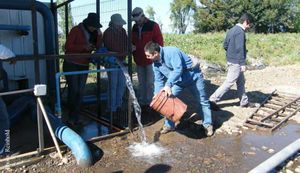Difference between revisions of "SPIS Toolbox - System Test"
***** (***** | *****) m (Protected "SPIS Toolbox - System Test" ([edit=sysop] (indefinite) [move=sysop] (indefinite))) |
***** (***** | *****) m |
||
| Line 55: | Line 55: | ||
*Testing must include pressure and water discharge measurements in all irrigation sections. | *Testing must include pressure and water discharge measurements in all irrigation sections. | ||
*Calibration of the irrigation discharge system is important to efficiently manage crop water distribution. | *Calibration of the irrigation discharge system is important to efficiently manage crop water distribution. | ||
| + | |||
{{SPIS Reference}} | {{SPIS Reference}} | ||
Revision as of 15:46, 18 July 2017

Introduction
The Toolbox on Solar Powered Irrigation Systems (SPIS) is designed to enable advisors, service providers and practitioners in the field of solar irrigation to provide broad hands-on guidance to end-users, policy-makers and financiers. Risks related to system efficiency, financial viability and the unsustainable use of water resources can thus be minimized. The Toolbox comprises informative modules supplemented with user-friendly software tools (calculations sheets, checklists, guidelines). read more
Modules and tools touch upon:
- assessing the water requirements,
- comparing the financial viability,
- determining farm profitability and payback of investment in SPIS,
- sustainably design and maintain a SPIS,
- highlight critical workmanship quality aspects,
- and many more.

style="width: 160px; background-color: rgb(111, 142, 43);" | ►Back to the Module Page
System Test
After the testing of the PV generator, the functionality of the other system components and their joint functionality must be checked and tested. This testing step should follow the same principles as the preceding PVP acceptance test. At least the following should be tested:
- water abstraction and discharge monitoring devices (water meters);
- distribution valves, distribution pipes and connectors;
- reservoir and filters (if part of the system);
- irrigation pipes and watering devices (emitters, mini sprinklers) by doing a Water Application Uniformity test.
The system test for the aforementioned components includes:
- Visual checks (bolts and screws, etc.);
- Mechanical check of mounting supports for tank and pipelines;
- Functional check of water distribution and discharge, storage tank and filter operation;
- Functional check of maintenance modus;
- Existence of system documentation (technical data sheets, hydraulic plan, operational procedures);
- Measurement of water pressure input and pressure distribution in all system sections and water discharge.
Measurements are usually carried out “from head to tail”, starting with the release of the water into the supply line (to storage tank or direct injection) and ending with the flushing outlets of the irrigation pipes. Pressure measurements have to be taken at all system joints / distribution knots to assess the hydraulic distribution in all sections. These measurements have to take into account the pressure variation during the day caused by fluctuating irradiance levels. The results need to be documented as a hydraulic profile of the irrigation system.
Calibration: The water discharge to the field needs to be calibrated in order to manage crop water distribution efficiently. Pressure differences may exist between different sections of the irrigation system and the pressure inputs vary in a PV pumping system without elevated storage, causing water discharge from the irrigation devices to differ from section to section and within the course of a day. The water discharge from the irrigation devices has to be measured at different times of the day to calculate the actual water discharge, which can then be managed by varying the irrigation interval per area unit.
Note: This calibration measurement is a time consuming exercise!
tool SET UP 02-Workmanship Quality Checklist comprises various workmanship indicators clustered into different categories. The purpose is to assess whether quality of installation adheres to best practices, safety requirements and overall installation sustainability.
Outcome/Product
- Completed system test for the irrigation system;
- Comparison of actual performance to design performance;
- System test protocol;
- Hydraulic profile of the irrigation system;
- Water discharge data for all irrigation sections.
Data Requirements
- Measured pressure and water discharge in all irrigation sections;
- Calculated system pressure and water discharge;
- Observations from visual check.
People/Stakeholders
- Producer;
- Installation service provider;
- Agricultural service provider.
Important Issues
- The on-site system test is mandatory to verify whether the irrigation systems achieve design performance.
- Testing should be done by the installer in presence of the producer.
- Testing must include pressure and water discharge measurements in all irrigation sections.
- Calibration of the irrigation discharge system is important to efficiently manage crop water distribution.




















